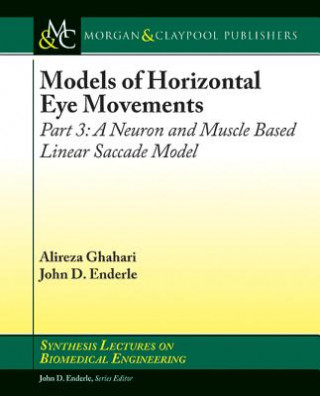
Kód: 10836590
Models of Horizontal Eye Movements
Autor John D. Enderle
There are five different types of eye movements: saccades, smooth pursuit, vestibular ocular eye movements, optokinetic eye movements, and vergence eye movements. The purpose of this book series is focused primarily on mathematica ... celý popis
- Jazyk:
 Angličtina
Angličtina - Vazba: Brožovaná
- Počet stran: 158
Nakladatelství: Morgan & Claypool Publishers, 2014
- Více informací o knize

Mohlo by se vám také líbit
Informovat o naskladnění knihy
Zadejte do formuláře e-mailovou adresu a jakmile knihu naskladníme, zašleme vám o tom zprávu. Pohlídáme vše za vás.
Více informací o knize Models of Horizontal Eye Movements
 Anotace knihy
Anotace knihy
There are five different types of eye movements: saccades, smooth pursuit, vestibular ocular eye movements, optokinetic eye movements, and vergence eye movements. The purpose of this book series is focused primarily on mathematical models of the horizontal saccadic eye movement system and the smooth pursuit system, rather than on how visual information is processed. A saccade is a fast eye movement used to acquire a target by placing the image of the target on the fovea. Smooth pursuit is a slow eye movement used to track a target as it moves by keeping the target on the fovea. The vestibular ocular movement is used to keep the eyes on a target during brief head movements. The optokinetic eye movement is a combination of saccadic and slow eye movements that keeps a full-field image stable on the retina during sustained head rotation. Each of these movements is a conjugate eye movement, that is, movements of both eyes together driven by a common neural source. A vergence movement is a non-conjugate eye movement allowing the eyes to track targets as they come closer or farther away. In Part 1, early models of saccades and smooth pursuit are presented. A number of oculomotor plant models are described therein beginning with the Westheimer model published in 1954, and up through our 1995 model involving a 4th-order oculomotor plant model. In Part 2, a 2009 version of a state-of-the-art model is presented for horizontal saccades that is 3rd-order and linear, and controlled by a physiologically based time-optimal neural network. In this book, a multiscale model of the saccade system is presented, focusing on the neural network. Chapter 1 summarizes a whole muscle model of the oculomotor plant based on the 2009 3rd-order and linear, and controlled by a physiologically based time-optimal neural network. Chapter 2 presents a neural network model of biophysical neurons in the midbrain for controlling oculomotor muscles during horizontal human saccades. To investigate horizontal saccade dynamics, a neural circuitry, including omnipause neuron, premotor excitatory and inhibitory burst neurons, long lead burst neuron, tonic neuron, interneuron, abducens nucleus, and oculomotor nucleus, is developed. A generic neuron model serves as the basis to match the characteristics of each type of neuron in the neural network. We wish to express our thanks to William Pruehsner for drawing many of the illustrations in this book.
 Parametry knihy
Parametry knihy
Zařazení knihy Knihy v angličtině Medicine Nursing & ancillary services Biomedical engineering
- Plný název: Models of Horizontal Eye Movements
- Podnázev: Part 3, A Neuron and Muscle Based Linear Saccade Model
- Autor: John D. Enderle
- Jazyk:
 Angličtina
Angličtina - Vazba: Brožovaná
- Počet stran: 158
- EAN: 9781627055468
- ISBN: 9781627055468
- ID: 10836590
- Nakladatelství: Morgan & Claypool Publishers
- Hmotnost: 314 g
- Rozměry: 192 × 235 × 15 mm
- Datum vydání: 01. October 2014
Oblíbené z jiného soudku
-

Safety Risk Management for Medical Devices
3612 Kč -

The Death of Death
581 Kč -

Ultimate BMAT Guide - 600 Practice Questions
906 Kč -

Corneal Biomechanics and Refractive Surgery
1665 Kč -

Medical Devices
3234 Kč -

Medical Device Guidelines and Regulations Handbook
4335 Kč -

Introduction to Biomaterials
2354 Kč -

Biodesign
2447 Kč -

Biomedical Microsystems
4175 Kč -

Comparative Kinesiology of the Human Body
4759 Kč -

Wearable Robotics
6422 Kč -

Analog Electronics for Radiation Detection
2769 Kč -

Biomedical Engineering
2045 Kč -

Cell Culture Technology
2065 Kč -

Organ Tissue Engineering
15373 Kč -

Electromagnetic Imaging for a Novel Generation of Medical Devices
4765 Kč -

Handbook of Biomechatronics
4597 Kč -

Science and Principles of Biodegradable and Bioresorbable Medical Polymers
8494 Kč -

Novel Biomaterials for Regenerative Medicine
6869 Kč -

Introduction to Clinical Engineering
2691 Kč -

Beginner's Guide to Data Agglomeration and Intelligent Sensing
5465 Kč -

Glucose Monitoring Devices
4190 Kč -

Air-Puff Tonometers
4735 Kč -

Handbook of Low-Level Laser Therapy
12835 Kč -

Polyurea
6449 Kč -

Clinical Engineering Handbook
6422 Kč -

Clinical Kinesiology and Biomechanics
2942 Kč -

Safety Risk Management for Medical Devices
5006 Kč -

Hydrogels for Wound Healing
8825 Kč -

Gellan Gum as a Biomedical Polymer
3397 Kč -

Medical Devices and In Vitro Diagnostics
11338 Kč -

Usability Testing of Medical Devices
5754 Kč -

Biomedical Signal Processing
3970 Kč -

Synthetic Polymers in Drug and Biotherapeutics Delivery
5528 Kč -

Artificial Intelligence in Dentistry
5561 Kč -

Artificial Intelligence-Based Brain-Computer Interface
5783 Kč -

Brain Seizure Detection and Classification Using EEG Signals
5465 Kč -

Computational Nanomedicine and Nanotechnology
2942 Kč -

Introduction to Instrumentation and Measurements
5946 Kč -

Neural Network Modeling and Identification of Dynamical Systems
4828 Kč -

Chitosan-Based Nanoparticles for Biomedical Applications
8117 Kč -

Advances in Artificial Intelligence
5708 Kč -

Natural Polymers in Wound Healing and Repair
7696 Kč -

Artificial Pancreas
5465 Kč -

Bioelectronic Nose
5060 Kč -

Functional Nanocomposite Hydrogels
6449 Kč -

Synthetic Biology
2998 Kč -

Principles of Biomedical Instrumentation
3073 Kč -

Fundamentals of Data Science
4185 Kč
Osobní odběr Praha, Brno a 12903 dalších
Copyright ©2008-24 nejlevnejsi-knihy.cz Všechna práva vyhrazenaSoukromíCookies




 Vrácení do měsíce
Vrácení do měsíce 571 999 099 (8-15.30h)
571 999 099 (8-15.30h)